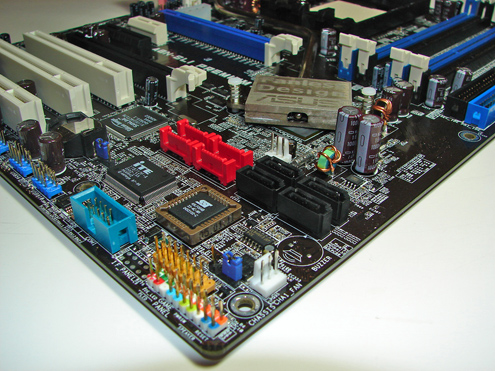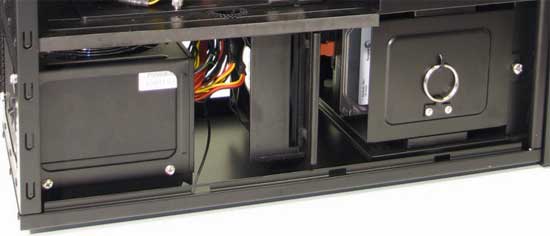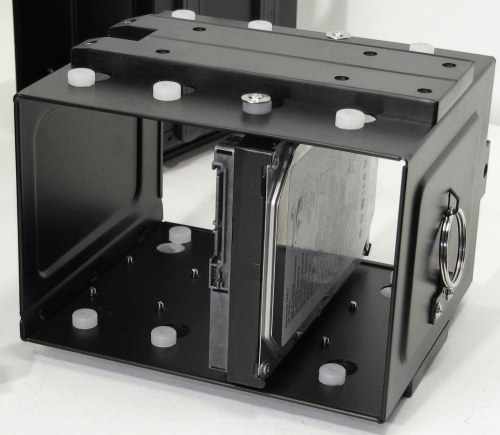A Lesson in User Failure: Investigating the Serial ATA Connector
by Ryan Smith on January 18, 2008 12:00 AM EST- Posted in
- Storage
SATA Anatomy, Failure Anatomy
It’s best to start first with a quick history lesson on the SATA design, as it hasn’t been static through the years. It has gone through some important revisions - some visible and some not – that have shaped the SATA connector in to what we see today. We’d also like to thank Knut Grimsrud, chairman of the SATA International Organization and Intel Fellow in their Technology & Manufacturing group for helping us out with this article and answering some of our questions.
First and foremost, the SATA-IO identified issues early on with the design of the SATA connector, and has revised it several times. This is most obvious in the move from the SATA 1 motherboard connector to the SATA 2 motherboard connector, where the SATA 1 motherboard connector was far more exposed than the SATA 2 connector. This switchover was particularly evident on boards using both native and external SATA controllers, where one would be SATA 2 compliant and the other SATA 1, requiring the different connectors.

The SATA 2 motherboard connector added shrouding around the connector, which significantly improved the durability of the connector as the shrouding prevented cables from easily bending the wafer part of the connector. Unfortunately this kind of shrouding couldn’t be added to SATA devices, because the standard was designed for use in small devices that don’t have clearance to fit a full shroud. This results in the modern half-shroud design for devices, where the top-half of the connector is shrouded by the device but not the bottom half.
The other significant changes in the standard since its inception have been latching and chamfering. Most SATA devices now have recesses in their top side shroud that allow barbs on SATA cables to latch in to in order to provide downward stability since the underside is the unshrouded side. Chamfering has been added to the square edges of the tongue, and while not a visibly dramatic change, we’ve been told this is one of the primary improvements in strengthening the SATA connector.
Yet in spite of these changes we’ve still managed to do something wrong and break the connector on our hard drive. For the reason why, we’ll start with case designs and cable designs.
Part of our problem can be attributed to the amount of space we have to work in with the case involved in this investigation, the Antec P182. The P182, like many other cases, doesn’t leave a lot of space behind the primary hard drive bay. For most cases this is because there are motherboard components and cards in the way, while with the P182 it’s a matter of a 120mm fan being located behind the hard drive bay, which helps pull air through the lower chamber. Either way, with this specific case, we measure that we have about 2” between the rear end of a hard drive and the fan, which is very little space to work in.

We then come to the cable, in this case it was a bog-standard cable that came with one of the products we’ve used over the years. As we mentioned earlier, SATA cables aren’t quite as flexible as PATA cables when it comes to longitudinal bending, and while we can technically bend a cable completely over at any location, this isn’t great because it causes the cable to pull back in to a more relaxed position. From the tip of the connector, the cable we measured needs about 2.5” of space to bend comfortably.

With the amount of clearance we have being less than the amount of space to need to ideally bend the cable, it becomes obvious that this will quickly become tricky. We need to bend the cable at a sharper angle so that it stays well clear of the fan, which means it’s going to be exerting some force on our hard drive, a generally acceptable but not ideal situation.
And then finally there is the layout of the P182’s hard drive bay. The P182 requires the hard drives to be installed in to the cage at an angle, such that they are on their sides with the bottom pointing towards the bottom of the case, which you can see here. Keep in mind the fact that the top hard drive is on the opposite side of the case from where the motherboard is.

In this combination, we have the anatomy of our failure. Our cable is putting force on the SATA data connector towards the bottom side, which as we covered earlier is the weaker direction to go because it’s not shrouded like the top side is. Furthermore we’re using a SATA-1 style cable without a latch, which means we don’t have said latch to reinforce the connection. It turns out that this is enough force to break the SATA data connector on our hard drive, and when the drive cage was being secured one day the connector broke.











62 Comments
View All Comments
RaulF - Friday, January 18, 2008 - link
I can't believe this, i call it Karma. This issue just happen to me last night, in the Antec P180. The funny part is that it was a locking sata cable, and everything was fine, until i pull the cable off and down came the plastic with it. I will try to Crazy glue the plastic today see if i can get all my data. Since i used it as a back up before installing my second raptor for raid 0. I have about 200GB worth of anime that i dont want to loose =(.P.S. Ordered a Hitachi 1TB HD today should have it tomorrow for back up and media services =). Lost time reader first time poster.
Kougar - Tuesday, January 22, 2008 - link
Well, add another victim to the list. Although I was lucky enough to already use the locking SATA cables, I instead broke off part of the plastic housing on a SATA power connector cable on my PC P&C Quad Silencer unit. I tell the amount of force being put on the cable when routinely inserting the drive cage into the case, somehow put to much force on the power cable and it snapped the protective plastic that covers the end of the power connector.Now it is just an exposed power connector that I can't use on a drive, and I suspect it won't be the last... trying to contort four pairs of both data and power cables to fit four drives in the lower P180 cage without hitting the fan has been nothing but a pain even with a fangaurd. Lesson learned for my next case purchase...
MastahYodah - Sunday, January 20, 2008 - link
Talk about karma; the same thing happened to me using the same antec p180 case. LOL!NiklasB - Monday, January 21, 2008 - link
Wellwell.. I did exactly this with a P182 and my brand new WDC Raptor driveRaulF - Friday, January 18, 2008 - link
Long...erikpurne - Friday, January 18, 2008 - link
"You keep on using that word. I do not think it means what you think it means."
kmmatney - Saturday, January 19, 2008 - link
Inconceivable!CorbaTheGeek - Friday, January 18, 2008 - link
"impervious," not "immutable."Guuts - Friday, January 18, 2008 - link
"immune" will work there, too.Ryan Smith - Friday, January 18, 2008 - link
Thanks.